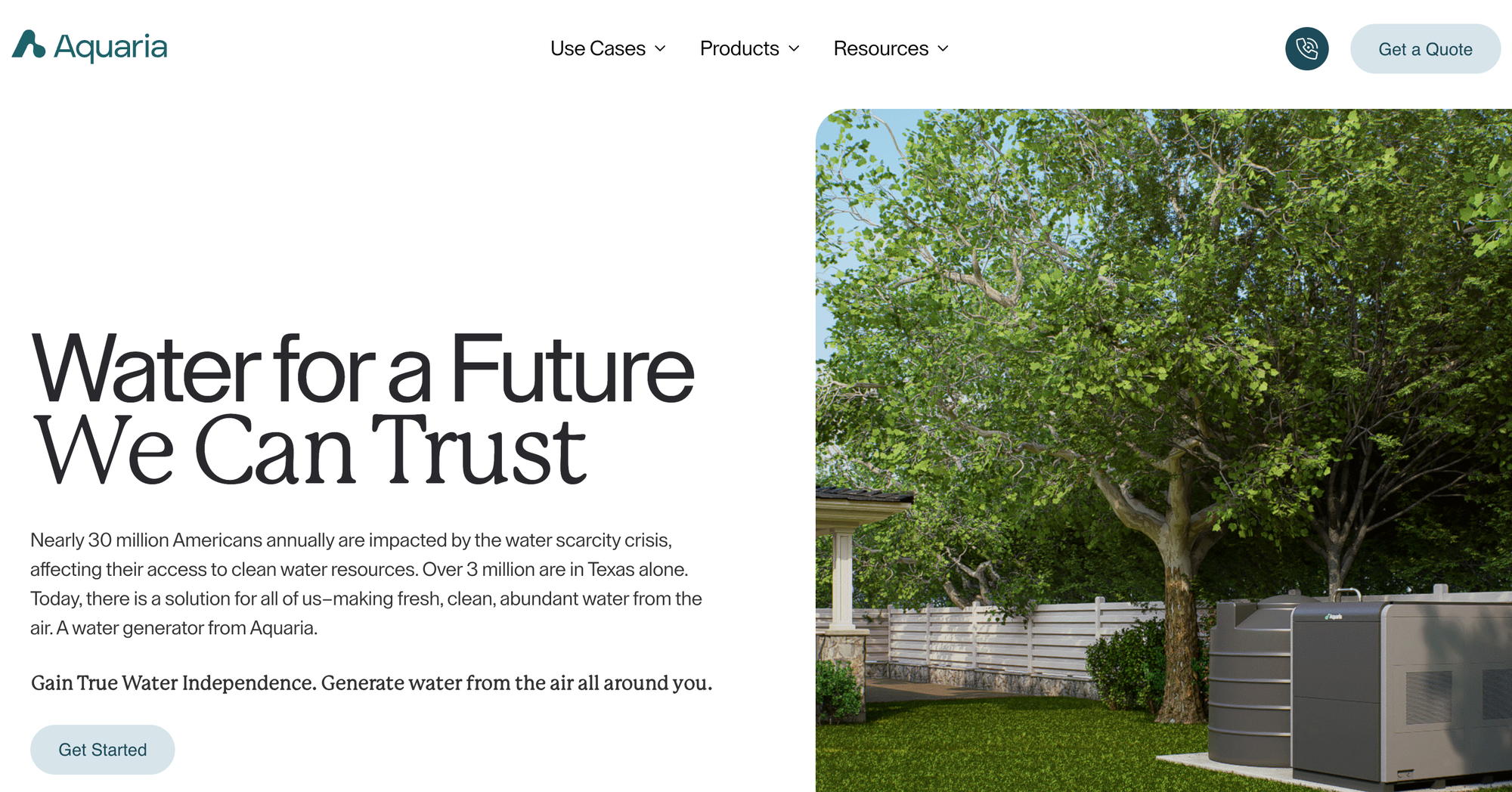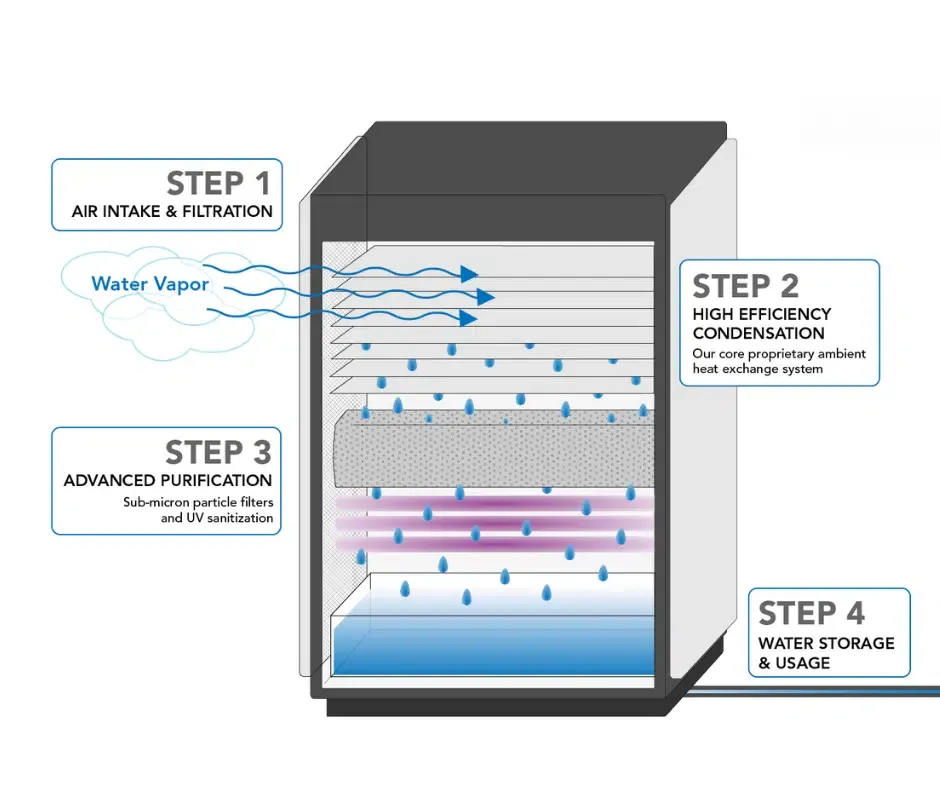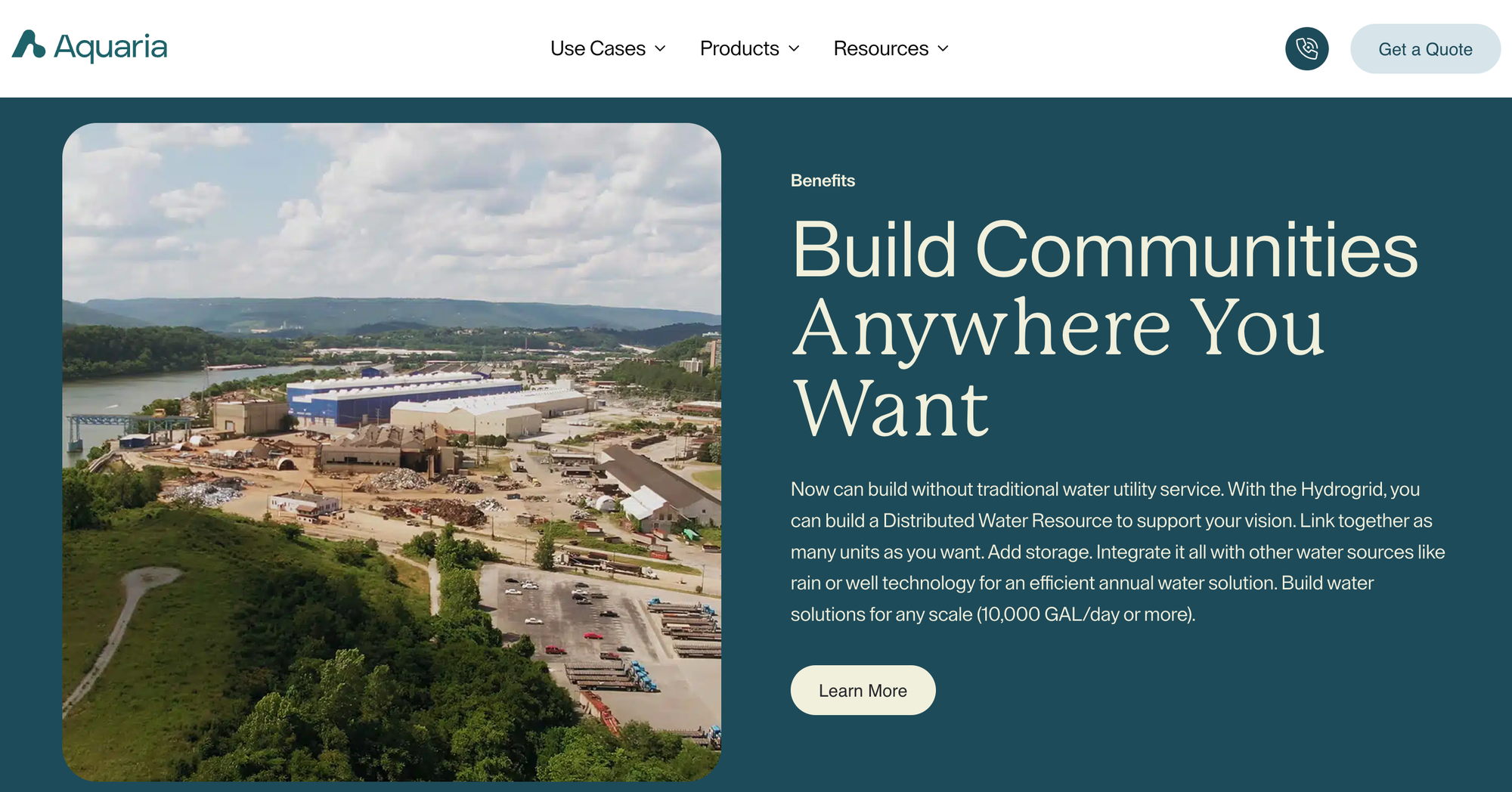In this episode of Disruptors for GOOD, we sit down with Brian Sheng, the visionary co-founder and CEO of Aquaria, to explore how his company is reshaping the future of water access.
At a time when nearly 30 million Americans are affected by water scarcity each year—and our infrastructure is failing to keep up—Aquaria offers a revolutionary solution: extracting clean, reliable water directly from the air.
Brian shares how an unexpected path led him into the world of climate tech, why aging water systems are a ticking time bomb, and how Aquaria is making water independence not only possible—but scalable. This is a must-listen for anyone passionate about sustainability, innovation, and the future of infrastructure.
Subscribe on Apple Podcasts
Subscribe on Spotify
Subscribe on Amazon Music
🎙 About Brian Sheng
Brian Sheng is the Co-Founder and CEO of Aquaria, a Public Benefit Corporation building the world’s first Air Water Infrastructure network.
A serial entrepreneur and Forbes 30 Under 30 honoree, Brian has dedicated his career to solving massive problems at the intersection of technology, infrastructure, and climate.
After witnessing the devastating water shortages in cities like São Paulo, Cape Town, and Mexico City, Brian partnered with his brother Eric to launch Aquaria. Their goal? To provide decentralized water security by harnessing a resource that’s all around us—air.
Today, Brian leads Aquaria with a bold vision: to serve 1 million people in water-scarce regions using atmospheric water generation (AWG) technology over the next decade. In his own words, "I consider this my life's work."

💧 About Aquaria
Aquaria is a climate-tech company using Atmospheric Water Generation (AWG) to produce clean water—anytime, anywhere—by condensing and purifying moisture from the air. Their technology doesn’t require pipelines, wells, or municipal connections. It's plug-and-play water independence.
Aquaria’s flagship products include the Hydropack series for households and the Hydrogrid platform for community-scale water infrastructure. These systems can generate from 66 to 10,000+ gallons of clean water per day, offering a sustainable alternative to aging or nonexistent water systems.
What sets Aquaria apart:
- ✅ No permits or plumbing needed
- 🌞 Solar-ready and energy efficient
- 🌎 Ideal for off-grid, emergency, and underserved communities
- 🏡 Focused on residential first—scaling to cities next
- 🤝 Partnerships with nonprofits, developers, and policymakers
With over $100M in financing secured and recognition from outlets like TIME’s Best Inventions of 2024, Aquaria is scaling fast. And it’s not just a business—it’s a movement to democratize access to clean water.
“We need more control of our water,” Brian says. “Aquaria gives that control back to the people.”

This episode is powered by PIF Advisory.
PIF Advisory is a global services firm that empowers startups and mission-driven companies with expert financial, operational, and strategic support.
Whether you're launching, scaling, or preparing for a funding round, PIF Advisory offers full-cycle bookkeeping, outsourced CFO services, growth marketing, entity management, and more—delivered by professionals and backed by a global investor network.
Episode Highlights and Takeaways
- Brian’s Journey: From venture capital to climate-tech founder, Brian’s path to Aquaria was unexpected but mission-driven.
- The Problem: America’s water infrastructure is outdated, vulnerable to drought, and lacks redundancy.
- The Opportunity: The atmosphere holds more water than we consume globally. Aquaria taps into this hidden resource.
- The Technology: AWG enables clean water production without interference to existing infrastructure.
- The Strategy: Starting with homeowners to prove scalability, then scaling into communities and cities.
- The Challenge: Policy is lagging behind innovation—regulatory support will be key to unlocking broader adoption.
- The Mission: Serve 1 million people with clean water from the air by 2035.

🔊 Sound Bites from the Episode
"We can provide water from the air."
"Water scarcity is a lagging problem that often goes unnoticed until it’s too late."
"I consider this my life’s work."
Episode Transcript
Grant
Awesome. Well, thanks so much for joining me today, Brian. I'm excited to chat about your journey. You’ve done some amazing things at a young age, and now with Aquaria, you're working on something incredibly innovative. Before we dive into the company, let’s rewind a bit. What was your journey like leading up to Aquaria, and was there an “aha” moment that inspired you to co-found it?
Brian
Thanks for having me, Grant. I’m really excited to share more about Aquaria and how it all started. Honestly, I didn’t expect that starting this company would change my life in such a significant way.
A quick anecdote—when I started Aquaria, it was right before the pandemic. What was supposed to be a 10-day international business trip turned into 18 months stuck abroad. I bounced between Singapore, Hong Kong, and Indonesia. It became a bit of a “side quest” in life, but I eventually came back and got to work.
Grant
Wow. So when you got back, were you ready to hit the ground running? Or did you have to start from scratch?
Brian
The origin of Aquaria actually goes way back. I studied energy and water infrastructure in college and wrote my thesis on the topic. Back in the early 2010s, there was so much innovation happening in solar, batteries, and electrification. But nobody was really talking about water—even though our water systems are aging, inefficient, and vulnerable.
That early curiosity stuck with me. Why weren’t we having more conversations about water? Eventually, that seed of a question grew into Aquaria.
Grant
So what’s the core mission and vision behind the company?
Brian
Our ultimate vision is to unlock a new source of abundant, clean water for societal development. Today, we rely on city systems, desalination, or groundwater—but those sources are becoming less reliable due to climate change, drought, and natural disasters. We need more flexibility and control.
Our belief is that the air around us holds the answer. With the right technology, we can harvest water from the atmosphere at scale. In the future, we want to supply entire cities with "sky water" instead of groundwater.
Grant
So how does it actually work—from a residential point of view?
Brian
You nailed it earlier! Yes, it’s all about extracting humidity from the air. If you live in places like New Orleans, where you can literally feel the moisture, then you already get it.
Think of morning dew or a glass of cold water collecting condensation. There’s an enormous amount of water in the air—actually over 200 times more than what humans consume globally.
The question is: how do we harvest that water efficiently and at scale?
That’s where our technology comes in. We’ve developed systems that pull moisture from the air, purify it, and then deliver clean, drinkable water. It’s highly scalable, energy-efficient, and doesn't interfere with existing infrastructure.
Grant
Let’s talk about the problem you’re solving—specifically here in the U.S., and especially in Texas where you're based.
Brian
Absolutely. The issue is multifaceted. America has some of the best innovation in the world—but our water infrastructure is not one of those strengths.
The average lifespan of our pipes is 30 to 35 years. Many of them were laid after World War II. Combine that aging infrastructure with booming population growth, industrial demand, and extreme weather—and we’re in trouble.
Places like Lake Mead and the Colorado River are at record lows. Texas, for example, is seeing 1,600 new residents every single day. Add in the strain from data centers, and we’re asking more of a system that’s already crumbling.
The problem is that water scarcity is often a lagging crisis—you don’t think about it until it’s too late.
Grant
So is this technology new, or are you building on something that already existed?
Brian
Atmospheric Water Generation (AWG) has existed for years—it started as a military technology funded by DARPA and ARPA-E to support troops in the field. But those units were bulky, expensive, and built for military budgets.
What we've done is take that core idea and make it scalable and accessible for homeowners and communities. It’s a bit like the evolution of computers—from NASA labs to laptops on every desk.
Today, you can buy an Aquaria system about the size of a desk, hook it up to a water tank, and get clean water from the air. We’ve even built the world’s first home where all the water comes from the sky—and we’ve expanded to Florida, California, Hawaii, and internationally.
Grant
Could this be integrated at the municipal level too?
Brian
Absolutely. In fact, that’s where we’re headed. The beauty of AWG is that it’s non-invasive. We’re not drawing from the same sources as traditional infrastructure, so there’s no interference.
But we also solve a speed problem. Building a desalination plant or replacing pipes takes years and hundreds of millions of dollars. With Aquaria, we can deploy in days or weeks. We're modular, scalable, and can work with governments, developers, or emergency response teams.
This year, we’ll build more than 500 homes with water from the sky. That’s just the beginning. There are over 90 million homes in the U.S., so we have a long way to go—but we’re making progress.
Grant
Does the system come with built-in filtration? Or do homeowners still need water filters?
Brian
Great question. Our systems include multiple stages of air and water purification. We filter the air first—removing pollen, dust, and other particles—then we condense and purify the water.
What comes out is ultra-clean, high-quality drinking water that exceeds EPA and WHO standards. Unlike groundwater, which varies based on your geography, air water is consistently pure.
Grant
Congrats on the recent $112 million funding round. What’s that journey been like as a founder?
Brian
Thank you. It’s been humbling. The funding makes headlines, but behind the scenes, we almost ran out of money three times in 18 months. It was emotionally brutal. There were moments where I truly thought we might lose everything.
Over time, I realized that fundraising is less about convincing people to believe in your vision, and more about communicating that vision clearly. I used to get frustrated that people didn’t understand the water problem. Now, I see that it’s my job to help them understand it.
Grant
Has your business model changed at all?
Brian
Not really. We sell the product outright, or customers can finance it over time—just like you would with solar panels. What’s shifted is our focus. We're all-in on homeowners now. We still support commercial projects, but our biggest impact comes from serving families directly.
There are 93 million homes in the U.S., and that’s our focus.
Grant
What about developers? Any conversations about integrating Aquaria into new housing developments?
Brian
Yes, absolutely. We’re already having those conversations. Developers often face water access issues—and many just don’t know our technology exists.
Just like solar is now required on new homes in California, we believe water generation will follow a similar path. Our systems can be integrated during the planning or retrofitting phases.
We welcome any developers listening to reach out. Let’s build future-proof homes together.
Grant
Are there any tax credits or policy incentives supporting this yet?
Brian
Not yet, and that’s a big opportunity. Most people don’t know this tech exists. We need more awareness so policymakers can start crafting programs like the 30% solar tax credit. That would drastically accelerate adoption.
Right now, our systems start at around $10,000—financing makes it accessible, but policy would make it even more affordable for more communities.
Grant
Final question—what’s your big goal for the next 5 to 10 years?
Brian
It’s simple: we want to serve 1 million people with clean water from the air. That’s our first big milestone. The more units we deploy, the more people we help. There’s no greenwashing here—our impact is direct and measurable.
One million people in the next decade. Then 20 million. Then 100 million. That’s the arc of this work—and I’m in it for the long haul.
Grant
Amazing, Brian. It’s been inspiring to hear your story. You’re building something that’s not only innovative, but essential for our future. Best of luck to you and the Aquaria team—and thanks again for joining me.
Brian
Thank you, Grant. I really appreciate the opportunity to share this. Hopefully this sparks curiosity—and maybe even action—from developers, policymakers, or just homeowners who want to take control of their water. And hey, you heard it here first on Disruptors for GOOD.








